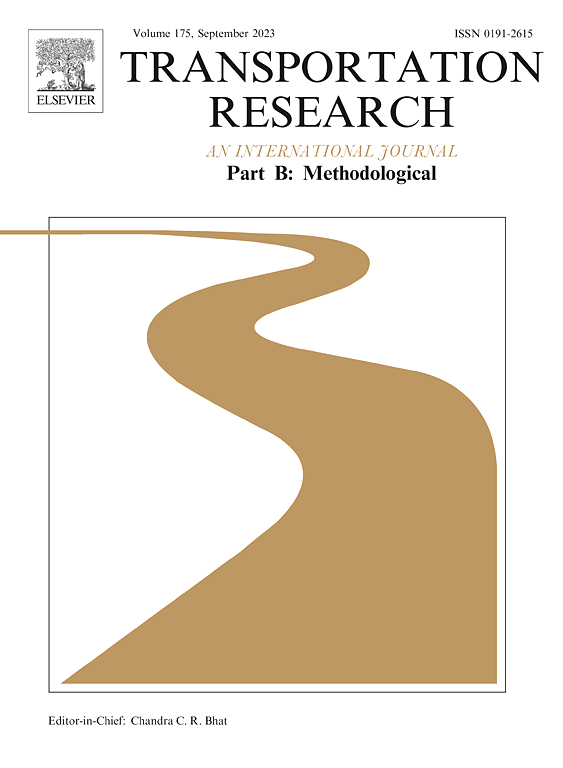考虑维修的城市轨道交通车辆段车辆分流作业规划
IF 6.3
1区 工程技术
Q1 ECONOMICS
引用次数: 0
摘要
本文以某铁路车辆段为研究对象,探讨车辆段车辆每日分流作业计划。给定一个车辆段的布局和在给定维修计划下到达和离开该车辆段的车辆,所研究的问题在于确定:1)每辆车辆停放、外洗和/或维修的位置;2)车辆在车辆段内移动的无冲突调车计划。我们将车辆段的轨道电路转换成不同的多层有向图来说明车辆的调车过程。通过这些图,我们将所研究的问题表述为一个混合整数线性规划模型,通过考虑在实践中有意义但在以前的工作中没有或很少考虑的四个要求的更一般的变体,并通过提出一种灵活的技术来建模轨道容量,以减少车辆的额外调车运动。此外,我们设计了一种两阶段分解方法来有效地解决实际问题实例,其中每个阶段的问题都由基于逻辑的Benders分解算法来解决,并通过定制的加速机制来增强。最后,研究了一组不同规模的现实和现实案例(来自中国重庆轨道交通3号线最大的车辆段)。计算结果表明,我们的最佳算法在大约8秒内解决了一个实际实例的最优性,这比铁路工作人员手动解决该实例的时间要短得多,因此我们的方法可以提供强大的自动计算机辅助决策支持。我们的方法在优化另一个也被广泛使用的目标方面也非常有效,可以为铁路工作人员提供管理见解。本文章由计算机程序翻译,如有差异,请以英文原文为准。
Rolling stock shunt operation planning in urban rail transit depots with maintenance consideration
This study investigates the daily rolling stock shunt operation planning in a rail depot. Given the layout of a depot and the rolling stocks (that arrive at and depart from this depot within an operation day) with given maintenance schedule, the studied problem lies in determining: 1) the position where each rolling stock is parked, outside washed, and/or maintained, and 2) the conflict-free shunting plan of rolling stocks to move within a depot. We transform the track-circuits in the depot into different multi-layer directed graphs to illustrate the shunting processes of rolling stocks. By means of these graphs, we formulate the studied problem as a mixed integer linear programming model by considering a more general variant of four requirements that make sense in practice but are not or rarely considered in previous works and by presenting a flexible technique to model the track capacity, to reduce the additional shunting movements of rolling stocks. Besides, we design a two-stage decomposition manner to efficiently solve real-life problem instances, wherein the problem in each stage is addressed by a presented logic-based Benders decomposition algorithm enhanced by customized acceleration mechanisms. Finally, a set of realistic and real-life instances with different scales (derived from the largest depot of the Chongqing Rail Transit Line 3 in China) are investigated. Computational results demonstrate that our best algorithm solves a real-life instance to optimality in approximately 8 s that is considerably shorter than the time of rail staffs to solve this instance manually, thus our approach can provide strong automatical computer-aided decision supports. Our approach is also very efficient in optimizing another objective that is also widely used, and can provide management insights to rail staffs.
求助全文
通过发布文献求助,成功后即可免费获取论文全文。
去求助
来源期刊
CiteScore
12.40
自引率
8.80%
发文量
143
审稿时长
14.1 weeks
期刊介绍:
Transportation Research: Part B publishes papers on all methodological aspects of the subject, particularly those that require mathematical analysis. The general theme of the journal is the development and solution of problems that are adequately motivated to deal with important aspects of the design and/or analysis of transportation systems. Areas covered include: traffic flow; design and analysis of transportation networks; control and scheduling; optimization; queuing theory; logistics; supply chains; development and application of statistical, econometric and mathematical models to address transportation problems; cost models; pricing and/or investment; traveler or shipper behavior; cost-benefit methodologies.

 求助内容:
求助内容: 应助结果提醒方式:
应助结果提醒方式:


